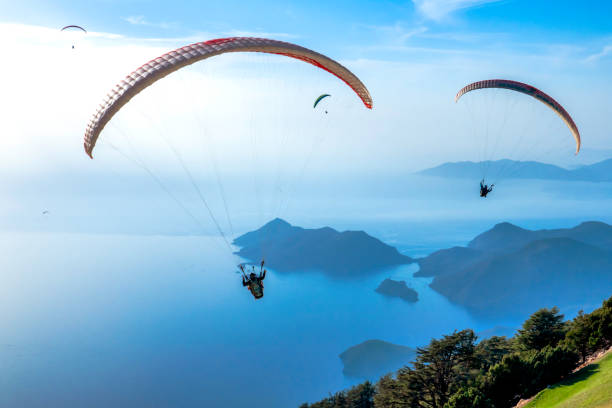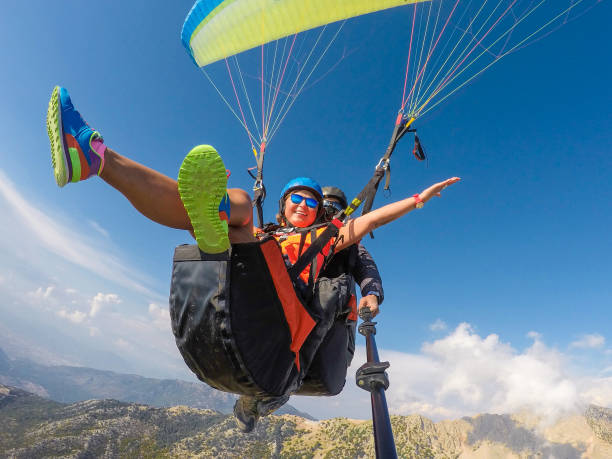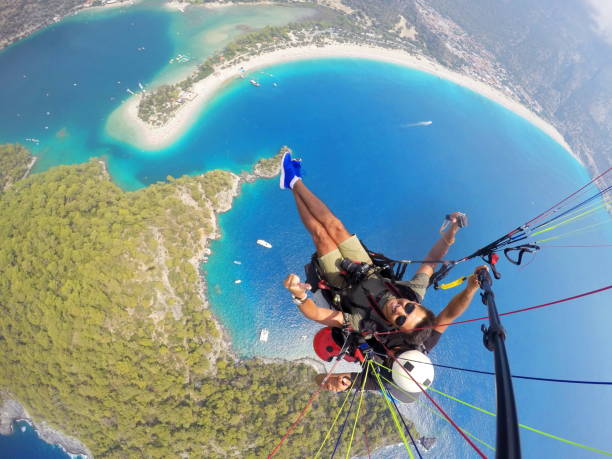A paragliding guide to understanding this new thrill-seeking sport!
Paragliding has emerged as a favored choice among the myriad of aerial sports, captivating the hearts and minds of daredevils and nature lovers alike. Paragliding has witnessed a surge in popularity worldwide with its unique blend of adrenaline rush and serene aerial views.
Paragliding, a sport involving lightweight, foot-launched gliders, has evolved from its humble beginnings to become a mainstream adventure activity. Originating in the 1940s, paragliding was initially practiced by a handful of pioneers who dared to dream of soaring through the skies like birds. Over the decades, advancements in technology, safety standards, and accessibility have transformed paragliding from an extreme pursuit to a recreational pastime enjoyed by people of all ages and backgrounds.

One of the key factors driving the popularity of paragliding is the sheer sense of freedom it offers. Unlike traditional aviation sports that rely on engines or complex machinery, paragliding harnesses the power of wind and thermals to keep enthusiasts aloft. This connection with the elements creates an unparalleled experience of floating through the air, unrestricted by the confines of conventional aircraft.
Furthermore, paragliding provides an intimate and immersive way to experience nature. From rugged mountain landscapes to coastal cliffs and rolling countryside, paragliders can explore diverse environments from a bird’s-eye perspective. The sensation of gliding silently above breathtaking scenery fosters a profound appreciation for the beauty and grandeur of the natural world.
Another factor contributing to the growing popularity of paragliding is the accessibility of training and equipment. With certified instructors offering courses in numerous locations worldwide, aspiring paragliders can undergo comprehensive training to learn the necessary skills and safety procedures. Additionally, advancements in glider design and materials have made paragliding equipment more lightweight, durable, and user-friendly, reducing barriers to entry for newcomers to the sport.

Social media platforms have also played a significant role in fueling the popularity of paragliding. Enthusiasts share awe-inspiring photos and videos of their flights, showcasing the exhilarating sensations and breathtaking views that paragliding offers. These digital narratives inspire others to embark on airborne adventures, contributing to a vibrant and interconnected community of worldwide paragliding enthusiasts.
The thrill of paragliding appeals to individuals seeking novel experiences and personal growth. Flying high above the ground requires courage, focus, and adaptability, fostering resilience and self-confidence. Paragliding encourages participants to embrace uncertainty and overcome challenges, leading to empowerment and fulfillment.

If you’re interested in experiencing the thrill of flying, here’s a step-by-step guide on what to do to start paragliding:
- Research and Understand: Begin by researching paragliding to understand the sport comprehensively. Familiarize yourself with the basics, including equipment, flying techniques, weather conditions, and safety protocols. Online resources, books, and videos can provide valuable insights into the world of paragliding.
- Find a Certified Instructor: Enroll in a reputable paragliding school or seek out a certified instructor in your area. Look for accredited instructors from recognized organizations such as the United States Hang Gliding and Paragliding Association (USHPA) or the Federation Aeronautique Internationale (FAI). Experienced instructors will provide structured training programs tailored to your skill level and learning pace.
- Take Lessons: Sign up for introductory lessons with your chosen instructor or school. Beginner courses typically cover essential topics such as ground handling, launching, landing, flight maneuvers, safety procedures, and emergency protocols. Hands-on practice in a controlled environment will help you develop the skills and confidence to progress to higher flying levels.
- Get Proper Gear: Invest in high-quality paragliding equipment, including a paraglider wing, harness, reserve parachute, helmet, and other essential accessories. Consult your instructor or experienced pilots for recommendations on suitable gear based on your weight, skill level, and flying objectives. Prioritize safety and choose equipment from reputable manufacturers that meet industry standards.
- Attend Ground School: Participate in ground school sessions to deepen your understanding of aerodynamics, meteorology, airspace regulations, and flight planning. Ground school curriculum may include classroom instruction, simulations, and interactive discussions to enhance your knowledge and decision-making skills as a pilot.
- Practice Regularly: Dedicate time to practice flying techniques and hone your skills under the guidance of your instructor. Take advantage of opportunities to fly in diverse weather conditions and terrain types to gain valuable experience and improve your proficiency as a pilot. Consistent practice and feedback will help you progress through the different stages of paragliding proficiency.
- Obtain Certification: Pursue certification through recognized governing bodies such as the USHPA or FAI upon completing your training and demonstrating competency in essential flying skills. Certification levels range from novice to advanced and require passing written exams, practical assessments, and proficiency requirements. Certification validates your skills and opens doors to flying opportunities at certified sites worldwide.
- Join a Community: Connect with the vibrant paragliding community by joining local clubs, online forums, and social media groups. Engage with experienced pilots, share insights, and participate in group flights, competitions, and events. Building relationships within the paragliding community fosters camaraderie, mentorship, and continued learning opportunities.
- Respect Safety Protocols: Prioritize safety and adhere to established safety protocols and guidelines. Stay informed about weather forecasts, wind conditions, airspace restrictions, and other factors that may impact your flights. Conduct pre-flight checks, assess risks, and exercise sound judgment to mitigate potential hazards and ensure a safe and enjoyable flying experience.
- Embrace Lifelong Learning: Paragliding is a dynamic and evolving sport that offers endless opportunities for growth and exploration. Commit to ongoing learning and skill development through advanced training courses, workshops, and cross-disciplinary experiences. Stay curious, stay humble, and embrace the journey of self-discovery and mastery as you soar to new heights in the exhilarating world of paragliding.

Despite its growing popularity, paragliding has risks. As a sport that involves flying at significant altitudes and navigating unpredictable weather conditions, paragliding requires a thorough understanding of aerodynamics, meteorology, and safety protocols. Responsible pilots prioritize ongoing training, conduct pre-flight assessments, and adhere to strict safety guidelines to mitigate potential hazards and ensure enjoyable, incident-free flights.
In conclusion, the growing popularity of paragliding reflects humanity’s enduring fascination with flight and exploration. As more people seek meaningful experiences that connect them with the natural world and push the boundaries of their comfort zones, paragliding offers an exhilarating blend of adventure, freedom, and serenity. With its accessibility, camaraderie, and transformative potential, paragliding continues to inspire individuals to spread their wings and soar to new heights.
